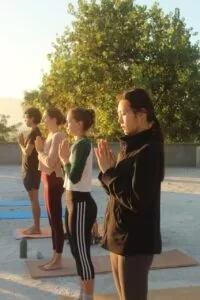Breathwork and yoga are two practices that are often combined to create a more mindful and meditative experience. Breathwork can help you achieve a state of mindfulness by allowing you to be fully aware of the moment and strengthen the connection between your mind and body.
Pranayama is a type of breathwork that is practised in yoga. It involves controlling your breath for positive effects, such as moving past emotional and energetic blocks that hinder the flow of your life force. Controlling your breath can improve your breathing patterns and reduce stress and anxiety.
Many different types of breathwork exercises can be practised in yoga, such as Ujjayi breath, NadiShodhana (alternate nostril breathing), Kapalabhati (breath of fire), and Bhramari (bee breath). These exercises can help you achieve deeper relaxation and focus during yoga.
Yoga and breathwork are two practices that are deeply intertwined. The connection between yoga and breathwork is essential. Learning to use the breath to enhance your yoga practice can deepen your experience and bring greater awareness to your body and mind. When you begin your yoga teacher training in India, you must first learn how to synchronize your breath with your movements.
- Introduction About Breath and Yoga
- Explanation of yoga and breathwork
Yoga is an ancient Indian practice mainly involving physical postures, breathing exercises, and meditation. Yogis have advocated breathing techniques, also known as pranayama, for thousands of years to balance their mind and body. It is also helpful in enhancing physical, mental, and emotional well-being. Breathing techniques can help to calm the mind, increase focus, and promote relaxation.
- Importance of breath in yoga practice
Breath is a crucial component of yoga practice. Yoga is made from the Sanskrit word “yuj,” which means “to unite.” This means the union of breath, body, and mind is achieved through yoga. Ancient yogis have detailed rhythmic deep breathing techniques that can affect the mind and body differently. This refers to the union of breath, body, and mind achieved through yoga practice. Breathing is often an overlooked part of yoga; however, you must know its importance. It helps you to focus your mind, release tension in your body, and achieve a greater sense of calm and relaxation.
- Benefits of combining yoga and breathwork
There are plenty of benefits to combining yoga and breathwork.
- Promote Relaxation
- Relieves stress and anxiety
- Lowers blood pressure
- Strengthens lungs
- Boost energy
- The Science Behind Breath and Yoga
- How breathing affects the body and mind
Breathing affects our bodies in every way. It helps in sustaining a bond between mind and body. So, when it comes to breathing, you must put effort into it. Not following the proper breathing techniques while practicing can increase body tension and anxiety. Conversely, maintaining a balance between breathing and yoga can promote relaxation and calmness.
- Importance of proper breathing in yoga
Every yoga practitioner must understand the importance of breathing, as breathing plays a vital role in the general yoga practice. Many yoga poses are specifically designed to coordinate movement with breath can only be done effectively with the right breathing techniques. It also paves the way for increased oxygen flow to your muscles, deepening your physical health.
- The role of breath in the mind-body connection
Breathing mindfully is the act of putting your full attention on your breath. By doing so, you strengthen the mind-body connection. This is because breathing is one of the only physical acts that are both automatic and controllable simultaneously. If the flow of breath is erratic, the thoughts are erratic. The mind is also the same if the breath is slow, smooth, long, and deep. Oxygenating the lungs also fills the brain with oxygen. When there is fresh air, thoughts flow in tune with nature.
III. Types of Breathwork in Yoga
- Pranayama
Pranayama is a type of breathwork that is commonly used in yoga practice. It involves various breathing techniques, including deep belly breathing, alternate nostril breathing, and breath retention. Pranayama can help to calm the mind, improve concentration, and reduce stress and anxiety.
- Ujjayi Breathing
Ujjayi breathing is a specific pranayama type often used in yoga practice. It involves breathing through the nose while constricting the back of the throat, which creates a soft, ocean-like sound. Ujjayi breathing can help to promote relaxation and reduce stress and anxiety.
- Kapalabhati Breath
Kapalabhati breath is a breathing technique that involves short, rapid exhalations followed by passive inhalations. It is sometimes called “skull-shining breath” because it is believed to help purify the mind and body. It is said to help clear the mind and energize the body.
- NadiShodhana Breath
Nadishodhana breath, also known as “alternate nostril breathing,” involves breathing in through one nostril and out through the other, alternating between the two. It is said to help balance the body’s energy channels and promote overall well-being.
- Bhramari Breath
Bhramari breath, or “bee breath,” involves inhaling deeply and then exhaling while making a humming sound. This technique can help to calm the mind and reduce stress and is often used in meditation and relaxation practices.
- Breathwork Techniques to Enhance Yoga Practice
- Breath awareness in yoga poses
You must focus on your breath whenever you do any yoga pose. You need to hold it for a few seconds and connect more deeply with your body.
- Incorporating breathwork during transitions
Another way to enhance your yoga practice with breathwork is to incorporate breathing techniques during transitions between poses. For example, you might inhale as you move into a pose and exhale as you move out.
- Using breath to deepen stretches
Breathwork can also help you to deepen your stretches and improve your flexibility. By breathing deeply and slowly into a stretch, you can release muscle tension and allow yourself to sink deeper into the pose.
- Breath retention techniques
Breath retention techniques involve holding the breath for a short period and can be used to promote mental clarity and focus. However, it’s important to approach these techniques with caution and only practice them under the guidance of a qualified teacher.
- Meditative breathwork
Yoga breathwork techniques are very if you are fond of meditation. Meditative breathwork lets you focus on the breath to quiet the mind and promote relaxation. In the beginning, you can follow simple techniques such as counting the number of times your breath or visualizing the flow of air in and out of the body.
- Benefits of Yoga and Breathwork
Yoga and breathwork have many benefits for both the mind and body. Here are some of the top benefits of practising yoga and breathwork:
- Relieves stress and anxiety: Practicing yoga breathing exercises signals to your body’s stress response that relaxing and returning to a normal functioning state is safe. A 2021 study found that participants who practised Sudarshan Kriya Yoga (SKY) breathwork practice reported less stress, anxiety, and depression and had improved sleep.
- Improves breathing patterns: Another key benefit of these practices is their ability to improve breathing patterns. By focusing on controlling their breath during yoga practice, individuals can improve their overall breathing patterns and lung capacity.
- Increases mindfulness: In addition to physical benefits, practicing yoga and breathwork can also enhance mental and emotional wellbeing. These practices can help individuals achieve a state of mindfulness and strengthen the connection between their mind and body.
- Boosts immunity: Yoga and breathwork practices can boost immunity.
- Common Challenges in Breathwork and Yoga Practice
- Difficulty focusing: One of the biggest challenges people face when practicing yoga and breathwork is difficulty focusing. To overcome this challenge, find a quiet space to practice without distractions.
- Physical limitations: Another common challenge is physical limitations. If you have any physical limitations or injuries, it’s important to modify your practice to avoid further injury.
- Breath control: Breath control can also be challenging for beginners. Start with simple breathing exercises and gradually work up to more advanced techniques to improve your breath control.
- Time constraints: Finding time to practice yoga and breathwork can be challenging. Try to set aside a specific time each day for your practice.
- Feeling lightheaded: While practicing breathing techniques in some yoga postures, you can experience light-headedness or dizziness. This mainly happens due to factors such as following improper breathing techniques and sometimes due to dehydration. To avoid these problems, you must seek guidance from a qualified teacher and follow safe breathing practices.
VII. Tips for Combining Yoga and Breathwork
- Start with simple techniques
As a beginner, you must build a strong foundation by focusing only on simple techniques first. Once you know breathing techniques in yoga, you can move to advanced practices and poses. This will help you avoid any issues such as bodily injury and discomfort.
- Practice regularly
Practice makes a man perfect; we all know this motto. So follow it as being consistent with your yoga practice will help you. You must practice regularly and incorporate proper breathing into your daily routine.
- Listen to your body
As with any physical practice, listening to your body and respecting your limitations is important. Suppose you experience pain or discomfort during a pose or breathing exercise; back off or modify the practice as needed.
- Seek guidance from a teacher
At last, you must seek guidance from a qualified teacher who can help you to learn safe breathwork techniques. A trained teacher can offer personalized guidance and feedback and help you progress quickly.
Conclusion
When you incorporate breathwork your daily yoga practice it helps to improve your physical, mental, and emotional well-being. If you are a beginner you can start with simple techniques, practice regularly, listen to your body, and seek guidance from a qualified teacher. Moreover, if you want to learn advanced breathwork techniques for yoga, contact Oceanic Yoga School, India’s top yoga teacher training school. Namaste.





